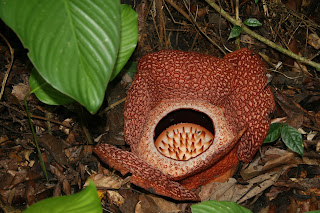After one of the coolest summers on record accompanied by too many complaints about plants not blooming and tomatoes not ripening due to a lack of sunshine, I thought, forget it, I’m taking off for somewhere a little warmer — Borneo.
To be truthful, the trip was planned long before I felt any need for a change in weather, but I certainly found the sun and warm temperatures — and acres of blooming bougainvillea, frangipani, and orchids, orchids, and even more orchids.
It was a lovely trip, plus any expectations I might have had before embarking were exceeded when I had the amazing good fortune, purely by chance, to see the largest flower in the world in bloom.
 |
| Mount Kinabalu |
We piled out of the bus into a steam bath wondering what the fuss was about. I can honestly say that I didn’t know much about Rafflesia, but the locals sure knew. As soon as they’d found it, up when the sign and out went the cash box. And who can blame them. In fact it’s encouraged as a means to protect this endangered species. I paid my thirty ringgits (about ten dollars), and stepped onto the trail through the forest. Fortunately, it was only a short walk along a freshly trampled track and there it was, the extremely rare Rafflesia arnoldii, protected by a hastily erected bamboo fence.
 |
| Rafflesia |
It’s a brown speckled plant and looks a little like a fungus, but it is a parasitic, vascular plant with a distinct fragrance. Believe me; it isn’t called the corpse flower for nothing — not to be confused with that other corpse flower, the Titum arum, which is a larger plant, but it doesn’t rank with Guinness as the largest flower because the arum is composed of multiple florets, rather than a single bloom. The carrion odour emitted by the Rafflesia attracts the flies that provide pollination duties, resulting in a single seed.
 |
| Rothschild orchid |
This solitary specimen lay behind a chain link fence, out of reach of drooling fans. It’s found only on the slopes of Mount Kinabalu Kota Kinabalu
No comments:
Post a Comment